
5076EN
Narrow Tractor
Features
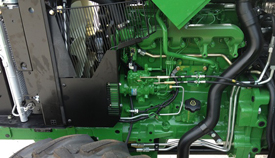 Ready-to-work, PowerTech engines
Ready-to-work, PowerTech engines
Owners of 5EN Narrow Series Tractors can claim bragging rights to operating the most dependable engine on the market with John Deere’s extensive track record for building high-performance engines. Both tractors use John Deere designed and manufactured diesel engines and provide excellent torque, fuel efficiency, and durability. These turbocharged engines comply with Tier 2 emission standards.
Model |
Cylinders |
Engine displacement |
Engine hp* |
Engine kW | PTO hp |
Rated rpm |
Aspiration |
5076EN |
4 |
4.5 L (1.19 gal.) |
75 |
55.9 | 64 (47.7 kW) |
2400 |
Turbocharged |
5090EN |
4 |
4.5 L (1.19 gal.) |
92 |
68.6 | 75 (55.9 kW) |
2400 |
Turbocharged |
*ISO 97/68 EC
Outstanding performance and durability
John Deere designed and manufactured diesel engines provide excellent torque, fuel efficiency, and durability.
Heavy-duty cylinder block
The heavy-duty cylinder block provides greater strength and rigidity that allows these tractors to perform in ditches, ravines, and other less than ideal conditions.
Balanced crankshaft
The statically and dynamically balanced crankshaft reduces engine vibration. The operator’s body absorbs less vibration allowing them to stay attentive and consistent throughout the work day.
Cast aluminum pistons
High-ring piston design reduces the non-usable air in the combustion area of the cylinders for improved fuel efficiency and combustion so the maximum power is received from every engine stroke. Ni-resist inserts reduce ring groove wear, which would lead to less effective combustion, so operators have an engine that is proactive for performance.
Tee-pee connecting rods and keystone-shaped top rings
Tee-pee connecting rods provide increased strength and durability of both the connecting rod and the pistons, which allows operators to run in a wide array of conditions.
Keystone shaped top rings move slightly in the groove to clean the carbon deposits, conditioning the tractor to remain ready to work. Plasma coated for reduced drag on cylinder wall and increasing overall tractor life.
Wet-type cylinder liners
Cylinder liners dissipate heat to prevent cylinder distortion and rapid ring wear, allowing consistent performance. Certified John Deere technicians can easily restore engine to the original specifications after many hours of hard operation. This extends the life and performance of the tractor.
Full-pressure lubrication system
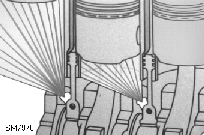 Piston-cooling jets
Piston-cooling jets
Full-pressure lubrication system ultimately protects the operator from maintenance costs. The underside of each piston and piston pin is sprayed with cooled and filtered oil, which eliminates excessive heat for longer life. The full-flow filter allows the cleanest fuel to be delivered to the engine for maximum performance and filter bypass so the tractor will never be starved for oil due to an exhausted filter.
Engine oil cooler
Engine oil cooler provides additional engine oil cooling, allowing operators to run in severe applications, reducing the likelihood that the engine will overheat.
Automotive-style poly V fan drive belt
The automotive-style fan drive belt drives the fan, water pump, and alternator. The belt features a self-adjusting spring tensioner, which eliminates service tasks, the need for a wrench, and extends the life of the belt because it is always in the correct adjustment.
Operate safely with the neutral start switch and electric fuel shutoff
A neutral start switch ensures operator and bystander safety; the right-hand gear shift lever must be in the park or neutral position for the engine to start.
Electric fuel shutoff allows the operator to easily turn the tractor off with the key, just like an automobile. A solenoid on the injection pump that permits using a key instead of a push-pull cable to shut off the engine. Electric fuel shutoff does not allow bypass starting. If an attempt is made to bypass start the tractor, through the use of electronics, the electric fuel shutoff will not allow the engine to start.
Dry-type air cleaner
A dry type air cleaner has a dual-element design for added engine protection against dust or debris from entering the combustion chamber, ensuring performance time opposed to shop time. Reaching the filter for service is easy; the operator simply unlatches three clips. A restriction indicator light on the dash alerts the operator when servicing is required to save potential engine repairs.
Single-element fuel filter
A single-element fuel filter partners up with the hand primer and water sediment bowl to deliver the complete package. John Deere designed specifically to meet the needs of John Deere tractors, the fuel filter provides a hand primer to prime the system for an easy fix for any operator who gets busy working and forgets to fuel. The water separator stores water separated from the fuel to protect from the cost of fuel injection pump failures due to water contamination.
Approved fuel
The use of biodiesel fuel up to 20 percent (B20) concentration is approved. Biodiesel fuel needs to meet ASTM PS 121 or DIN 51606 specifications. A local fuel supplier can provide specifications.
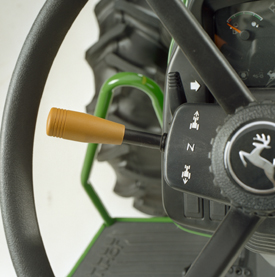 Electrohydraulic reverser lever
Electrohydraulic reverser lever
The PowrReverser transmission provides 12 forward speeds and 12 (12F/12R) reverse speeds for operators requiring additional operating ranges for field work and other applications. The 12F/12R PowrReverser with shiftable 540/540 economy PTO is ideal for operators using their tractors to perform in demanding applications.
Hydraulic wet forward and reverse clutches maximize durability and will outlast the life of any dry clutch. When tractors are run by multiple operators with a variety of experience levels, a wet clutch is the best way to maintain transmission integrity and performance while decreasing clutch replacement costs.
Two platform-mounted levers offer easy and comfortable shifting for a pleasant operator experience. The gear-shift lever is easy to reach and the less-used range lever is now shorter. Unique knobs make it easier to distinguish between the two. The forward lever selects one of four speeds, all synchronized shifts for on-the-go shifting with the use of the clutch. The range lever selects collar-shift A, B, and C ranges, which are not synchronized.
Maximum productivity is achieved with hydraulic shift between forward and reverse and is ideal for loader and rear blade applications that require frequent directional changes in tight spaces. Excellent modulation allows the operator to shift the direction lever from neutral to forward or reverse, forward to reverse, reverse to forward, or to neutral from forward or reverse.
Operators can accomplish all these directional changes without sacrificing comfort or having to press the clutch pedal. The speed of directional changes can be adjusted to the operator’s preference or application demands with the field-installed infinitely variable control kit.
An electrohydraulic fingertip directional lever control allows the operator to effortlessly switch directions with a small finger motion. The control is located on the left side of the instrument console and selects the forward, reverse, and neutral positions.
It also allows the operator to steer and shift direction with the left hand, freeing the right hand to operate other tractor controls, such as the loader joystick, rear implements, or hand throttle.
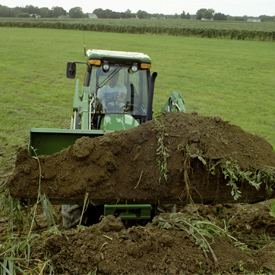 Narrow tractor with loader
Narrow tractor with loader
Constant-mesh, helical-cut gears provide quieter operation and excellent reliability while the pressure-lubricated top shaft adds to the transmission durability. Fully enclosed, rigid shift linkages for short throw and crisp shifts enable all operators to clearly know in what range and gear they are operating.
Positive park pawl on the transmission provides positive park and eliminates the need for a hand brake. This also eliminates clutch service costs that occur when the park brake is accidentally left engaged during operation.
A neutral start switch requires the directional lever to be in the neutral position to start the engine. This is both a safety and convenience feature.
See also the following information:
- 12F/12R transmission ground speeds for narrows
- Ground speeds with creeper kit (16-speed transmission)
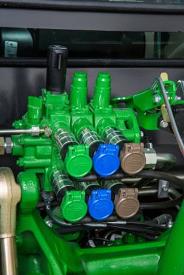 Triple rear SCV
Triple rear SCV
A maximum of three rear SCVs can be field installed or factory installed to add versatility. Dual rear SCVs with lever controls come standard on 5EN Series Utility Tractors.
All rear SCVs are lever controlled and couplers are equipped with plug dust covers to prevent dirt and debris from entering the hydraulic system. This ensures the most reliable performance, allowing operators to get their work done.
Operators can couple and uncouple under pressure with the International Standards for Organization (ISO) push-pull couplers, which reduces the muscle required to switch implements. This allows the operator to effortlessly couple and uncouple hydraulic hoses from one implement to another.
The SCV and rockshaft valve can be adapted to provide live hydraulic power, power beyond, to implements with an independent control valve.
Deluxe triple-rear SCVs
Triple-deluxe, lever controlled rear hydraulics is available as factory installed and is designed to help operators run more efficiently. This hydraulic option provides additional solutions to meet operator hydraulic needs and expands the array of implements that can be utilized.
The SCVs are stackable, with the first valve being equipped with flow control, allowing operators to run a hydraulic motor. The first SCV has a float position as well as a knob with three selectable detents: no detent, continuous flow, and auto-kick out.
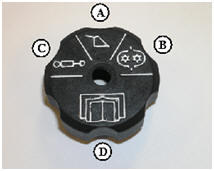 Detent selector
Detent selector
A knob on valve provides three selectable detents to create an easy operating experience in every task; even the novice operator can be productive.
The most familiar detent is the no-detent selection (A) which functions identically to the single and dual valves. The cylinder responds as the operator pulls or pushes the lever to retract or extend the cylinder. An example of where this may be used is when a loader is hooked up to the rear hydraulics or when using a box blade with top and tilt.
The second detent is continuous flow (B), which is ideal for running hydraulic motors. This is on each valve; however, the first valve provides the best performance with flow control by decreasing the amount of heat generated by the application. An example of where this detent may be used is with a hydraulic hay rake or planter.
The third setting is auto-kick out (C). The cylinder completes a stroke and then kicks out, so an operator doesn’t have to provide pressure on the control. This is useful in applications when the hydraulic implement is frequently raised and lowered during operation. An example of where this may be used is with a disk or rotary cutter.
The fourth symbol appearing on the knob is an opened book (D). This is to remind operators to refer to their operator’s manual for proper operation and assistance when help is needed.
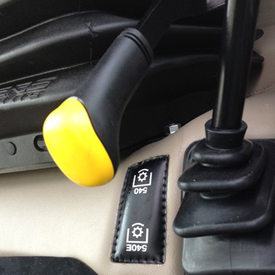 Shiftable 540/540 Economy PTO (5EN Cab)
Shiftable 540/540 Economy PTO (5EN Cab)
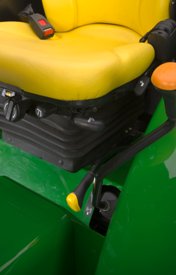 Shiftable 540/540 Economy PTO (5EN OOS)
Shiftable 540/540 Economy PTO (5EN OOS)
The 540/540 economy PTO allows operators to select the optimal engine rpm needed for their PTO applications.
The economy position provides 540 rpm to the PTO at 1700 engine rpm. The 540 economy is ideal for any lighter-duty PTO application, from running a mower-conditioner, a baler or a cutter, where full horsepower is not needed.
Operating at lower engine rpm saves fuel during some tasks. The overall operating experience improves because there is also less noise and overall tractor vibration for the operator.
A lever allows the operator to change between 540 and 540E when conditions merit the opportunity to save fuel without affecting performance.
For heavy-duty operations requiring maximum PTO power, the PTO shift lever is placed in the 540 position, the PTO is engaged, and the engine is run at a rated speed of 2400 rpm. This selection gives 540 rpm to the PTO shaft and delivers the fully-advertised horsepower at rated engine speed.
The 540/540 economy PTO offers all the features of the standard 540-rpm PTO, and the safety interlock is a foolproof measure provided to compensate for operator oversight.
When the tractor is in economy, the engine is limited to 1700 rpm, preventing accidental over-speeding of PTO implements and protecting against binding the PTO shaft.
The safety interlock also prevents accidental shifting of the PTO selector lever at engine speeds above 1700 rpm, which would lead to downtime for fixing implements or drivetrains.
